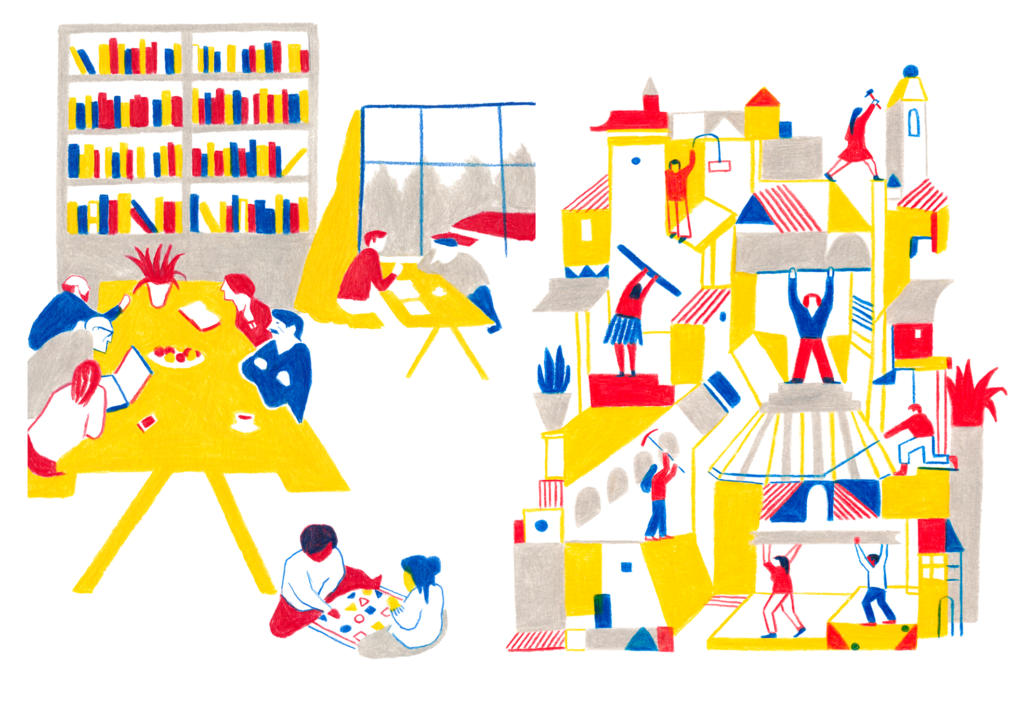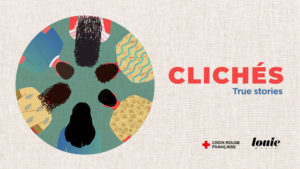
Illustration: Pau Gasol Valls
Description
Halfway between the home and the workplace, the third place is a place of conviviality and socialising, where everyone gives and everyone receives. Users co-construct a programme of activities that meet local needs. With the modern-day challenges facing social organisations, the third place appears to be an effective tool for adapting the local capacity of the French Red Cross to these challenges by transforming its local chapters into citizen platforms.
Context
The phenomena of industrialisation, globalisation and the digital revolution have profoundly transformed French territories – generating a proliferation of social needs and isolation, a lack of citizen participation in decision-making and the scarcity of public resources. Moreover, the evolution of means of engagement puts in danger the traditional actions of solidarity.
While new technologies are becoming more and more essential for social and administrative procedures, 1 in 6 French people do not use the Internet and more than 1 in 3 users lack basic digital skills (INSEE, 2019). Furthermore, despite the increasing use of social networks, 1 in 9 French people suffer from social isolation (INSEE, 2019). The disappearance of places of socialisation is certainly related to this trend: only 34,000 of the 600,000 cafés that existed in France in 1960 remain today.
Technical details & Operations
To be relevant “wherever it is needed”, the French Red Cross has therefore chosen to adapt to contemporary challenges by reinventing its way of acting at the local level. By enabling a community of citizens to mobilise around a local response that is resilient and adapted to social needs, the model of the ‘Third Place’ appears to be a powerful lever for transformation.
Invented in the 1980s by the American sociologist Ray Oldenburg, the term refers to a ‘Third Place’, between home (the first place) and work (the second). It is a “home away from home”: a warm, friendly meeting place, where one can benefit from services and opportunities. Open to all ages and social backgrounds, it creates favourable conditions for meetings and exchanges between people. Moreover, by allowing everyone to contribute to the life of the place, it overcomes the traditional power dynamic between the volunteer and the beneficiary, in which the former gives and the latter receives. Run by and for its users, the Third Place offers a new form of engagement in the life of the neighbourhood.
The French Red Cross has thus started the transformation of its local chapters into citizen impact platforms that offer responses tailored to local needs. The five pillars of the Third Places are :
- “Eating well”: an intergenerational vegetable garden, solidarity restaurant, cooking workshops ;
- “Dress well”: solidarity second-hand clothes shop;
- “Take good care of yourself”: health, prevention and awareness centre;
- “Good housing”: administrative support, inclusive housing;
- “Social integration”: support to unemployed people, digital learning.
The methodology for transforming an establishment or local unit of the French Red Cross into a Third Place of solidarity is based on a participatory and inclusive approach that consists of seven steps :
- Instigate a cultural change to co-opt employees and volunteers into the vision of Third Places. To do this, project leaders can be inspired by similar projects run by other French Red Cross local chapters or other external organisations.
- Create a community, bringing together community, public and private partners, local residents and people supported by the French Red Cross. The cohesion of this community prefigures the future use of the Third Place and its shared ownership between all stakeholders.
- Establish collectively a problem analysis of the local area and co-construct solutions to identified needs.
- Build a sustainable, hybrid financial model in order to cover the overhead costs. Persuade institutional partners to support the project and apply for co-financing. The Third Place finds an financial balance between operating income, equity capital and external subsidies.
- Establish open governance. The success of a Third Place depends on its shared ownership by a wide variety of publics: the decision-making mechanism must find a balance between efficiency and inclusion.
- Start activities as soon as the community is ready (before the Third Place space itself is fully defined).
- Ensure the programme of activities of the Third Place takes into account the space that will be used (opportunities and constraints). Depending on the real estate owned by the organisation carrying out the transformation, several possibilities may be considered: extension of existing premises, renting, occupation or purchase of municipal land, construction financed by a partner.
Deployment & Impact
The French Red Cross has therefore launched a national experiment led by the Direction of Innovation and Transformation. Between October 2017 and December 2019, six pilot sites located in rural and semi-urban areas were supported, including three voluntary organisations and two medico-social establishments. Here is the list of the six sites:
- “La Boussole”, Montbrison (Loire, 42)
- “Chez Nous”, Saint-Jans-Cappel (Nord, 59)
- “L’Entrepause”, Verdun-sur-Garonne (Tarn-et-Garonne, 82)
- Local chapter of Chateauponsac (Nouvelle-Aquitaine, 87)
- “La Plateforme”, Monistrol-sur-Loire (Haute-Loire, 43)
- “La Marmite”, Puy-en-Velay (Haute-Loire, 43)
In this experiment, the Association was supported by operational partners such as the Coopérative Tiers-Lieux. In addition, more than 20 local partners (community organisations, local authorities, companies, media) were involved, either by co-leading a project or by providing it with human and/or material resources.
The Third Place experiment (2017-2019), which had its share of failures and successes, was rich in lessons for the pursuit of the local innovation strategy and the consolidation of a Third Place methodology. The Third Place has proved to be a useful tool for fighting social divides and meeting the needs of local areas. If it enables rural areas to be revitalised through cultural and economic activity, it is also effective in developing the skills of its users.
Nevertheless, the French Red Cross has realised that the temporality and consequent cost of real estate projects are a major obstacle to the development of Third Places. This is why the Association is now placing greater emphasis on the collective citizen and partnership approach and on the flexibility of its activities so as not to depend on real estate constraints and to produce a rapid and significant social impact.
Finally, as each project requires a great deal of time and resources, it would not be realistic or applicable to transform all French Red Cross structures into solidarity-based Third Places. However, changes in professional practices and modes of intervention can be spread throughout the Association’s network. It is essential today to share knowledge about past experience in order to inspire and train other employees and volunteers.
The French Red Cross has capitalised on this experience by creating a methodological guide and training 26 “Third Place ambassadors”, i.e. volunteers and employees of the French Red Cross in charge of the local area transformation.





